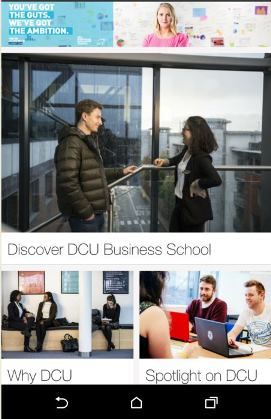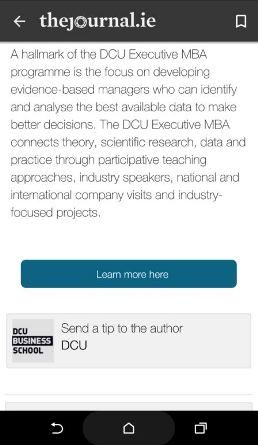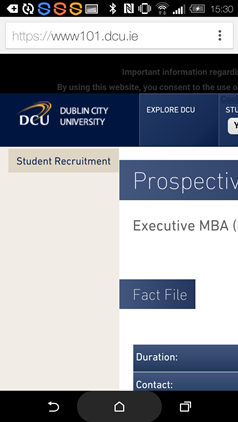Marketing departments in universities & colleges are increasingly under pressure to show the tangible impact of their marketing activities and, importantly, marketing spend. It’s all about conversions, click through stats and analysis. What worked, what didn’t work and how do we fix it or improve it? How much do we spend offline versus online? Where do we place our banner ads? How much money do we give Google? The options are growing exponentially and the stress for marketers and student recruiters often leads to sleepless nights (insert empathetic sigh).
Sometimes you just have to go back to basics – Marketing 101 if you will. Know your audience, know where they consume information and hit them with targeted and relevant content. Simple right? Well it’s not always the case but when’s it done right we feel the need to applaud and highlight; case in point Dublin City University (DCU).
DCU is one of the largest universities in Ireland and lauded as a leader in social innovation in higher education.
Disclosure: We must point out that we love to hire DCU graduates. Many of our Dublin team (past, present and future) are DCU graduates based on the quality of its courses and ‘employment-ready ‘approach to learning.
DCU’s Masters Campaign
Like every university or college marketing team there are generally a million cogs moving at any one time. The marketing and recruitment strategies are usually vast, complex and ever evolving. But we thought we’d focus on a snippet, a moment-in-time of a campaign we liked a lot for its focus and targeting i.e. DCU’s Masters Campaign or at least one element of it i.e. Native Ads.
While perusing TheJournal.ie one day we happened upon this sponsored ad for DCU Business Schools' Masters Degrees.

Now there’s nothing hugely special about the ad in terms of ground-breaking artwork. But that’s not the point. TheJournal.ie has 435,000 daily readers and 53% of those readers are between 25-44 years of age; an absolute sweet spot for those considering a master’s degree. Focused and targeted audience for an age profile with disposal income and generally working their way up the career ladder and additional qualifications help to this end.
So the TheJournal.ie makes sense for this sponsored ad. We click into the ad and it’s clear and simple. The messaging is spot on and I know where I am, where I want to go and how I get there. I’m a prospect and I’m loving this.


I’m intrigued. I want more information about the course. The content is short and concise but importantly engaging. I’m hooked and I want even more information. The Call to Action is clear i.e. Learn More Here. I click the button and I’m taken to the DCU micro site. Wonderful!
Brief Interlude: The Case for Native Ads
It’s worth noting that native ads are increasingly replacing banner ads in these types of campaigns. Think about it. When is the last time you tapped on an ad on your phone? The truth is mobile users either ignore them or worse get irritated by them. Native ads fit the natural form and function of the platform they appear on. They blend with the host site’s existing content and drive higher engagement rates than banner ads.
In 2015 the Ovum Group completed a survey on behalf of the Interactive Advertising Bureau and among the findings it highlighted that U.S. mobile marketers listed mobile native as the second most important development in mobile marketing today. Responsive design was listed first. Check out the full Ovum Report.
Feedback is a gift
Anyone that’s ever had a performance reviews knows that line ‘feedback is a gift’ and we’ve some for DCU Business School. As we’ve said we love the simplicity and concept of this campaign but we experienced a small let down in user experience at the very final hurdle. The micro site we were directed to wasn’t correctly responsive and this was a problem on a mobile device as it did not allow you to scroll up or down. It was difficult to read the page and find an obvious onsite call to action (that can be tracked with analytics).

While there were calls to actions on the landing page these included an email address and a number to call. These are perfectly acceptable but perhaps an online form would have been a stronger option allowing Google Analytics to track but also providing insights into form abandonment etc.
But this shouldn’t take away from DCU Business School’s campaign which we imagine served its purpose i.e. increased conversion and enquiries for its courses. In a world where stunts, gorilla campaigns and large pricey events garner all the attention it’s worth reflecting and appreciating campaigns that are logical, targeted, cohesive and results focused. We tip our hat to you DCU and look forward to watching what’s next.
Final thoughts
Inspired by DCU’s campaign we thought we’d put together a useful checklist of things to consider when rolling out a similar campaign:
- Make sure the campaign has been thoroughly tested on mobile devices (and not just emulators)
- Set relevant and meaningful KPIs (try to avoid including vanity metrics). Upon completion you should be able to identify the number of enquiries and ultimately applications this campaign generated. This puts financials on the campaign performance and serves to get budget for future campaigns.
- Make sure you’re measuring your KPIs in real-time and that you are setting the flags in whatever marketing automation/lead generation service you use.
- Have short enquiry CTA forms (and check they submit to your CRM correctly).
- Check that all links from your campaign micro site are valid and showing up-to-date data
- Check your content for accuracy e.g. dates, times, costs etc.
- Review the campaign data to gauge success

:format()//media/Bravo.jpg)